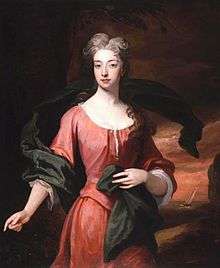Elizabeth Southwell
| Elizabeth Southwell | |
|---|---|
 Elizabeth Southwell in 1705 | |
| Spouse(s) | Edward Southwell |
|
Issue | |
| Noble family | Cromwell |
| Father | Vere Essex Cromwell, 4th Earl of Ardglass |
| Mother | Catherine Hamilton |
| Born | 3 December 1674 |
| Died | 31 March 1709 (aged 34) |
| Buried | Henbury |
Elizabeth Southwell (née Cromwell), called Lady Cromwell (1674–1709) was an English noblewoman, the only daughter of Vere Essex Cromwell, 4th Earl of Ardglass and wife Catherine Hamilton.
Title
When her father died in 1687, she claimed his title of Baron Cromwell of Oakham, although his Earldom and Viscountship became extinct; she was ranked with the Peeresses at the funeral of Queen Mary II and the coronation of Queen Anne, but her claim appears to have been a mistake.[1]
Whether she was entitled to succeed her father depends on how the barony was created. A barony by writ descends to an only daughter, if a baron have no sons; a barony by patent follows the rule of descent given in the patent - normally to the male heirs of the grantee, which would exclude daughters.[1]
The Barony of Cromwell has a patent, granted in 1540 to Gregory Cromwell, 1st Baron Cromwell of Oakham (and his heirs male), son of Henry VIII's Minister Thomas Cromwell, after his father's fall and execution. But the antiquarian William Dugdale had claimed in the 1670s that there was also a writ summoning Gregory Cromwell as Baron Cromwell, dated 28 April 1539. Although he gives a text of the writ, the form is not standard, and no writs at all are recorded as being issued on that day - the first day of Parliament, and so rather late to summon men to attend it; the Complete Peerage conjectures that Dugdale saw a reference to Lord Cromwell in the proceedings of the Parliament, deduced that it meant the son - not the father - and supplied the writ he assumed must exist.[2][3] Gregory Cromwell was, however, elected as one of the Knights of the Shire for Kent in 1539, and was summoned to Parliament that year to sit in the House of Commons.[4]
Marriage and issue
She married, 29 Oct 1704, Edward Southwell, Secretary of State for Ireland, in 1703, a year after the death of his father, Sir Robert Southwell; their son Edward Southwell did not call himself Baron Cromwell of Oakham. Her grandson inherited the much older and more distinguished Barony of Clifford as its 20th holder.
Death
Elizabeth died of consumption on 31 March 1709 and was buried at Henbury. In a letter to Lord Raby, on 1 April 1709, Lady Wentworth wrote that "Your old Mrs. is dead and left thre lovly boys behynde and a dismall mallancolly husband ; its Lady Betty Southwell whoe made a very good wife, and he a fond husband."[1][5]
References
- 1 2 3 Cokayne 1913, p. 559
- ↑ Cokayne 1913, pp. 557, 559 The editor, Vicary Gibbs, suspected that Dugdale had assumed that the Earl of Essex mentioned in the reports was Thomas Cromwell, the father, but Henry Bourchier, 2nd Earl of Essex was still alive in 1539, and Thomas was still only Baron Cromwell.
- ↑ Journal of the House of Lords: volume 1: 1509-1577. British-history.ac.uk. p. 104. Retrieved 16 November 2013.
- ↑ Hawkyard 1982
- ↑ Cartwright 1883, p. 70
Bibliography
- "Ardglass, Earl of (I, 1645 - 1687). Cracroft's Peerage". Cracroftspeerage.co.uk. Retrieved 16 November 2013.
- Burke, Bernard (1866). A Genealogical History of the dormant, abeyant, forfeited and extinct peerages of the British Empire. London: Harrison.
- Cartwright, James J., ed. (1883). The Wentworth Papers, 1705-1739. London: Wyman & Sons.
- Cokayne, G. E. (1910). Gibbs, Vicary, ed. The Complete Peerage of England, Scotland, Ireland, Great Britain and the United Kingdom, Extant, Extinct or Dormant, vol. I. London: St. Catherine Press.
- Cokayne, G. E. (1913). Gibbs, Vicary, ed. The Complete Peerage of England, Scotland, Ireland, Great Britain and the United Kingdom, vol. III. London: St. Catherine Press.
- "Cromwell, Baron (E, 1540 - 1687).Cracroft's Peerage". Cracroftspeerage.co.uk. Retrieved 15 November 2013.
- "Elizabeth Cromwell, "Baroness Cromwell", Family Search: Community Trees. British Isles. Peerage, Baronetage, and Landed Gentry Families with Extended Lineage". Histfam.familysearch.org. Retrieved 15 November 2013.
- Hawkyard, A. D. K. (1982). "CROMWELL, Gregory (by 1516-51), of Lewes, Suss.; Leeds Castle, Kent and Launde, Leics.". In Bindoff, S. T. Members. The History of Parliament: the House of Commons 1509-1558. Historyofparliamentonline.org. Retrieved 16 November 2013.
- "House of Lords Journal Volume 1: 28 April 1539". Journal of the House of Lords: volume 1: 1509-1577. British-history.ac.uk. Retrieved 16 November 2013.
External links
- Elizabeth Cromwell, "Baroness Cromwell" Family tree
- Portraits of Elizabeth Southwell (née Cromwell), Lady Cromwell at the National Portrait Gallery, London
